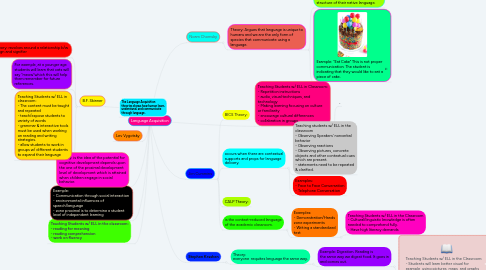
1. Teaching Students w/ ELL in the classroom: - reading for meaning - reading comprehension - work on fluency
2. Example: - Communication through social interaction - environmental influences of speech/language - zone proximal is to determine a student level of independent learning
3. Theory: is the idea of the potential for cognitive development depends upon the one of the proximal development level of development which is attained when children engage in social behavior.
4. B.F. Skinner
4.1. Theory: revolves around a relationship b/w a sign and signifier
4.2. For example, at a younger age students will learn that cats will say "meow"which this will help them remember for future references.
4.3. Teaching Students w/ ELL in classroom: - The content must be taught and repeated - teach/expose students to variety of words - grammar & interactive tools must be used when working on reading and writing strategies. - allow students to work in groups w/ different students to expand their language
5. The Language Acquisition theories shows how human learn, understand, and communicate through language.
6. Lev Vygotsky
7. Teaching Students w/ ELL in Classroom: - Repetition instructions - audio, visual techniques, and technology - Making learning focusing on culture or familiarity - encourage cultural differences - collabration in groups
7.1. F
8. Noam Chomsky
8.1. Theory: Argues that language is unique to humans and we are the only form of species that communicate using a language.
8.1.1. Students will begin to learn sentence structure of their native language.
8.1.2. Example: "Eat Cake" This is not proper communication. The student is indicating that they would like to eat a piece of cake.
9. Jim Cummins
9.1. BICS Theory:
9.2. occurs when there are contextual supports and props for language delivery.
9.2.1. Teaching students w/ ELL in the classroom - Observing Speakers' nonverbal behavior - Observing reactions - Observing pictures, concrete objects and other contextual cues which are present. - statements need to be repeated & clarified.
9.2.2. Examples: - Face to Face Conversation - Telephone Conversation
9.3. CALP Theory:
9.4. is the context-reduced language of the academic classroom.
9.4.1. Examples: - Demonstration/Hands zone experiments - Writing a standardized test
9.4.1.1. Teaching Students w/ ELL in the Classroom - Cultural/linguistic knowledge is often needed to comprehend fully. - Have high literacy demands
10. Stephen Krashen
10.1. Theory: everyone requites language the same way.
10.1.1. Example: Digestion. Reading is the same way we digest food. It goes in and comes out.
10.1.1.1. Teaching Students w/ ELL in the Classroom: - Students will learn better visual for example, using pictures, maps, and graphs
